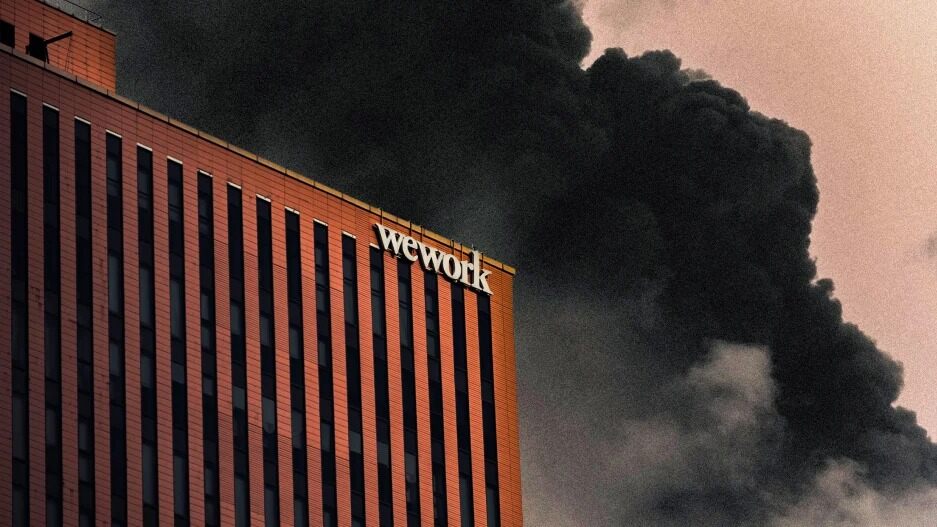- | 8:00 am
Why WeWork couldn’t pivot its way out of trouble
WeWork’s inability to straighten itself out suggests that the fundamental problem with the company was much deeper than Adam Neumann’s lack of focus.

WeWork, the real estate company that was once valued at $47 billion and is now worth a few hundred million, had a grim piece of news for investors in its second-quarter earnings release last week, saying that because of its continued losses, “substantial doubt exists about the [c]ompany’s ability to continue as a going concern.” In other words, in four years the company has gone from WeWork to WeCrashed to WeMightBeGoingBankrupt.
It wasn’t supposed to be this way. In fall 2019, WeWork pulled its planned initial public offering and got rid of Adam Neumann, its CEO and founder, whose pie-in-the-sky dreams of reinventing not just office space but, well, everything led him to expand the operation at a breakneck pace. Neumann piled up billions in losses and alienated investors with his kooky style and cavalier approach to corporate governance. So the hope was that ditching Neumann and bringing in professional management would allow WeWork to become a real, profitable company.
WeWork hired a CEO with real estate experience. It laid off employees and trimmed expenses. Instead of Neumann’s vision of his company as a vehicle for transforming lots of different industries, the new WeWork was going to be a straightforward office-management and subleasing company. It would lease spaces from commercial landlords, build them out, and then rent them to big companies, small businesses, and individual workers who wanted office space without the hassle of managing it themselves—and with the ability to rent for months rather than years.
But WeWork has nonetheless struggled. Initially one might have blamed the COVID-19 pandemic, which hit a few months after Neumann’s departure and crushed the market for office space. But things have gone badly even since the overall economy has gotten back on track.
WeWork’s CEO and CFO both departed in May. And although the company restructured its debt earlier this year and has reduced its long-term lease obligations, it still lost $351 million on its operations in its most recent quarter, and it had free cash flow of negative $646 million in the first half of the year. That’s a problem, considering it has only $239 million in cash and cash equivalents on hand.
WeWork’s inability to straighten itself out suggests that the fundamental problem with the company was deeper than Neumann’s lack of focus. Instead, it was that his essential strategy was deeply risky and had no margin for error built into it. It was a strategy designed for the era when WeWork arose: Money was cheap and growth was everything. When times changed, it couldn’t.
WeWork’s core business, ultimately, is rent arbitrage: leasing spaces and then charging its customers more than it spends. (Steven Roth, founder of Vornado Realty Trust, toasted Neumann at a WeWork event in 2014 by joking that WeWork rented properties at half the asking price and charged its customers three times as much.) That’s not a terrible idea for a business, especially at a time when hybrid work arrangements are more popular than ever.
And WeWork supposedly had certain advantages. It packed in its customers: Where the typical office allocates 250 square feet per person, WeWork facilities offer just 50 square feet. Since WeWork became one of the biggest—if not the biggest—customers for commercial real estate in many cities, WeWork executives said it would have extra bargaining power with landlords, guaranteeing it good lease terms.
It all might have panned out if WeWork had built slowly and steadily and focused on being profitable. But that was antithetical to Neumann’s vision (and to the goals of the venture capitalists who backed him). Instead the idea was to get big at all costs—literally. In 2018, WeWork had $1.8 billion in revenue but a remarkable $1.9 billion in losses. In other words, it was spending more than twice what it was bringing in.
That kind of rapid expansion can make sense if you’re in a business where economies of scale matter a lot. But subleasing isn’t really that kind of business. More important, while WeWork touted itself as a flexible, adaptable, asset-light company, the reality was that it was making massive long-term commitments: Even today, after slimming down, it has $13.3 billion in long-term lease obligations.
WeWork’s customers, by contrast, are mostly on short-term arrangements that they can easily get out of. So when demand for office space cratered during the pandemic, it put a big dent in the business. And even as that demand has returned, WeWork still doesn’t know how long most of its customers are going to stay. It has to keep working to stop churn, and it has to keep spending money to bring in new customers to counteract it. Far from being asset-light, WeWork is more anchored than its customers are.
This is a familiar story. WeWork touted itself as a totally new kind of company. But its decline looks uncannily similar to that of the U.S. arm of office-rental company Regus, which went bankrupt in 2003. Regus had expanded rapidly during the dot-com bubble, but it went bust when the bubble burst, the U.S. economy went into recession, and demand for office space plummeted. (It eventually came out of bankruptcy and, now wiser, is ironically one of WeWork’s chief competitors.)
Adam Neumann, then, wasn’t reinventing the office-space business so much as he was repeating a flawed strategy that others had tried before. It worked out great for him—he walked away from WeWork a billionaire. But it left his company in an impossible position. Neumann’s ethos was go big or go home. He went big. WeWork is on the verge of going home.








































